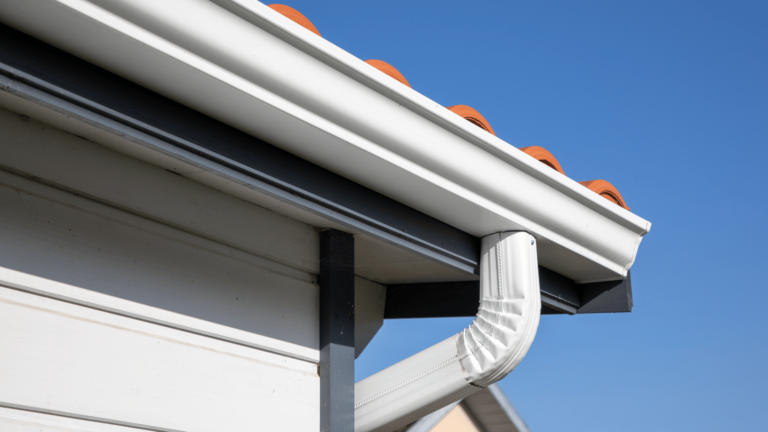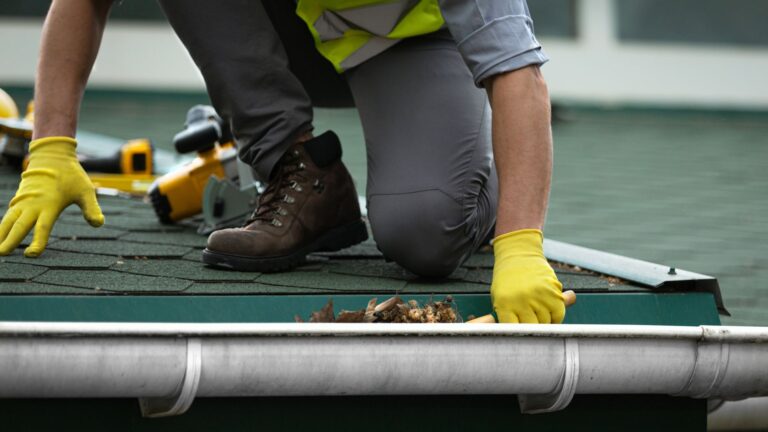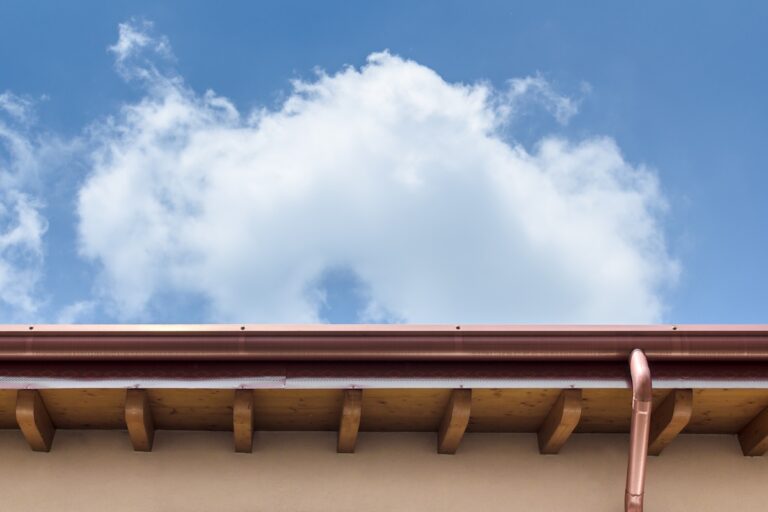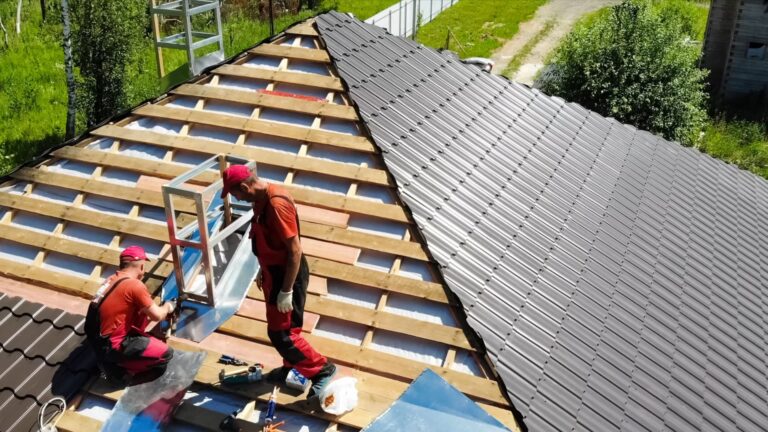Many homeowners in New Jersey are increasingly drawn to DIY gutter installation. Largely motivated by the desire to save money and take control of home improvement projects. With countless YouTube tutorials, online forums, and big-box retailers promoting DIY-friendly gutter systems, it’s easy to see why the average homeowner might feel confident enough to tackle the job. For some, it’s a matter of convenience and pride—being able to say they handled the task themselves without hiring a contractor.
However, reality often tells a different story. While the upfront costs of materials may seem affordable, hidden expenses can add up quickly. From purchasing the right tools and equipment to dealing with mistakes that require professional repairs. Many DIYers find themselves spending far more than anticipated. Improper installation can lead to serious issues such as water damage, foundation problems, or mold growth—costing homeowners thousands down the line. What starts as a money-saving initiative often turns into a costly lesson in the value of professional expertise.
Table of Contents
The New Jersey Climate: Why It Demands Professional Gutter Solutions
New Jersey’s diverse and often unpredictable climate poses unique challenges for homeowners, especially when it comes to managing rainwater and snowmelt. With heavy spring rains, intense summer storms, and harsh winter snowfalls followed by freeze-thaw cycles, gutters in NJ homes must be resilient and precisely installed to handle varying conditions throughout the year. These weather patterns put significant strain on gutter systems, making it essential that they are built and positioned to withstand seasonal shifts without sagging, clogging, or leaking.
Professional gutter solutions are tailored to meet these specific environmental demands. Properly pitched gutters, correctly sized downspouts, and durable materials ensure efficient water flow and prevent costly issues like foundation erosion, basement flooding, and ice dam formation. In New Jersey, where moisture management is critical for protecting home structures, professional installation goes beyond appearance—it’s a safeguard against long-term water damage. DIY methods often miss these nuances, putting homeowners at risk of poor drainage and weather-related wear that can lead to far more expensive repairs.
Material Costs: Are You Really Saving Money?"
Factor | DIY Option (Perceived Savings) | Reality / Hidden Costs |
Material Choice | Opting for cheaper materials like vinyl | Vinyl cracks easily in cold NJ weather; short lifespan means replacement costs add up |
Aluminum (moderate cost, DIY-friendly) | May dent or warp if not installed properly | |
Copper (premium cost, high durability) | DIYers often avoid due to upfront cost, but long-term value and durability are unmatched | |
Waste from Inaccurate Measurements | Homeowners often overbuy or cut materials incorrectly | Wasted sections can’t be reused; extra trips to hardware stores add time and money |
Cost of Trial and Error | Mistakes during cutting, fitting, or sealing seem minor | Rework may require additional tools, sealants, or full material replacement |
Professional Advantage | Avoided due to perceived high service cost | Pros buy in bulk at better rates, waste less, and ensure correct installation on first try |
Tools and Equipment: The Unexpected Expenses
Essential Tools Add Up Quickly
- Gutter installation requires more than just basic hand tools. You’ll need power drills, levels, tin snips or saws, crimpers, rivet guns, sealants, and proper safety gear such as gloves and eye protection.
- Many homeowners underestimate how many of these tools they either don’t own or need to upgrade for the job.
- Gutter installation requires more than just basic hand tools. You’ll need power drills, levels, tin snips or saws, crimpers, rivet guns, sealants, and proper safety gear such as gloves and eye protection.
Rental vs. Purchase Dilemma
- Renting specialized tools might seem cost-effective at first, but rental fees accumulate quickly—especially if the project takes longer than expected.
- Purchasing tools for a one-time job often ends up being more expensive than hiring a professional.
- Renting specialized tools might seem cost-effective at first, but rental fees accumulate quickly—especially if the project takes longer than expected.
Ladder Safety: A Serious Concern
- A sturdy extension ladder is critical for safe gutter installation, especially for multi-story homes.
- Improper ladder use leads to thousands of injuries every year, and homeowners carry full liability if accidents occur during a DIY job.
- Professionals come equipped with safety harnesses, insurance, and the training needed to work at heights safely.
- A sturdy extension ladder is critical for safe gutter installation, especially for multi-story homes.
The Hidden Price of Being Unprepared
- If a tool breaks or you realize you’re missing key equipment mid-project, it results in delays, added costs, and frustration.
- Professionals arrive with everything needed, ensuring efficient, accurate installation the first time.
- If a tool breaks or you realize you’re missing key equipment mid-project, it results in delays, added costs, and frustration.
Installation Errors: The Long-Term Financial Damage"
When gutters are installed without the proper slope and pitch, water doesn’t drain efficiently—leading to pooling, overflow, and eventual sagging. Many DIYers underestimate the precision required to angle gutters correctly, which can result in long-term damage like rotting fascia boards, water intrusion, and mold growth. In addition, incorrect fastening and improper spacing of brackets may not be noticeable at first, but over time, the weight of rainwater or snow can cause the gutters to pull away from the roofline, creating expensive repair issues.
Another major concern with DIY gutter installation is the poor placement of downspouts. If downspouts are not strategically located or are too short to direct water away from the home, the excess runoff can seep into the ground near the foundation. Over time, this leads to cracks, basement leaks, and even structural damage—some of the most costly repairs a homeowner can face. Small mistakes during installation may seem harmless, but they often result in serious financial consequences down the line. Hiring a professional can help avoid these risks and ensure your home’s drainage system is built to last.
Time Investment and Opportunity Costs
Many homeowners underestimate just how much time a DIY gutter installation project can consume. From researching proper installation techniques and shopping for materials to multiple trips to the hardware store and the actual hands-on labor, the hours add up quickly. What may initially seem like a weekend project often extends into several days—especially for those unfamiliar with the tools or techniques required. Unexpected complications like uneven fascia boards or tricky rooflines can turn the job into a frustrating and drawn-out process.
While the idea of saving money is appealing, it’s important to consider the value of your personal time. Every hour spent on a DIY project is time taken away from work, family, or other responsibilities. In contrast, a professional team can often complete a full gutter installation in just a few hours with precision and minimal disruption. When factoring in lost free time, potential mistakes, and the cost of future repairs, the apparent savings from DIY quickly diminish. Professional efficiency often proves to be the more economical—and less stressful—choice in the long run.
Lack of Warranty and Professional Guarantee
No Warranty with DIY Installation
- When you install gutters yourself, you take on full responsibility for the outcome.
- If something goes wrong—such as leaks, sagging, or improper drainage—there’s no coverage or compensation for repairs.
- When you install gutters yourself, you take on full responsibility for the outcome.
Risk of Costly Mistakes
- Errors made during DIY installation can lead to expensive damage, and you’ll have to cover all repair costs out of pocket.
- Even small installation flaws may void manufacturer warranties on the gutter materials.
- Errors made during DIY installation can lead to expensive damage, and you’ll have to cover all repair costs out of pocket.
Professionals Offer Peace of Mind
- Licensed contractors typically provide warranties that cover both labor and materials.
- If an issue arises due to installation or product failure, the repair or replacement is usually covered at no extra cost.
- Licensed contractors typically provide warranties that cover both labor and materials.
No Recourse if Something Goes Wrong
- DIY installations typically have no warranty coverage—if a mistake leads to damage, all repair costs come out of your pocket.
- Errors that aren’t immediately obvious can result in significant long-term damage with no protection or support.
No Labor or Material Warranty
- Most manufacturers offer warranties on materials only when installed by certified professionals.
- DIY work may void both material and system warranties due to improper installation or unauthorized alterations.
Professionals Offer Peace of Mind
- Reputable contractors provide warranties on both labor and materials, ensuring you’re covered if issues arise post-installation.
- Some pros offer extended warranties or service guarantees, offering long-term protection and maintenance support.
Higher Risk of Costly Mistakes
- Without warranty protection, even a small error—like improper pitch or a faulty seal—can lead to water damage, mold, or foundation issues.
- DIY mistakes often require professional correction, leading to double-spending: once on DIY materials and again on repairs.
No Post-Installation Support
- Unlike professional services, DIY projects come with no aftercare. If a gutter starts to leak or separate from the fascia, you’re on your own.
- Lack of expert guidance means minor issues may go unaddressed until they become major problems.
Insurance Complications
- Improper or uncertified gutter installations can affect your homeowner’s insurance claims in the event of water damage.
- Insurers may deny claims if the cause of damage is traced back to unlicensed or unverified work.
Building Codes and HOA Compliance in NJ
In New Jersey, gutter installation isn’t just about functionality—it also involves adherence to local building codes and, in many cases, homeowners association (HOA) regulations. These rules exist to ensure proper water drainage, structural integrity, and neighborhood uniformity. DIY installers often overlook key legal requirements such as minimum slope, proper downspout placement, or approved materials, which can result in code violations. For those living in HOA-governed communities, non-compliant gutter styles or colors can trigger formal complaints and mandatory changes.
Failing to comply with these standards can lead to more than just a slap on the wrist. Homeowners may face fines, be required to remove or redo the entire installation, or encounter problems when selling the property. Even more critically, improper installation that violates code may invalidate your homeowner’s insurance, especially if it leads to water damage. Insurance companies can deny claims if the damage results from unapproved or non-compliant work. This makes professional gutter installation not just a smart choice, but a necessary one to avoid legal and financial repercussions.
Potential Safety Hazards
Installing gutters may seem simple, but it comes with serious safety risks—especially for those inexperienced with working at heights. Climbing ladders, walking on roofs, and handling heavy materials all increase the risk of falls and injuries. Every year, thousands of homeowners end up in emergency rooms due to ladder-related accidents during home improvement projects. Gutter installation often requires maneuvering around power lines, sharp tools, and unstable surfaces—all of which add to the danger.
Beyond personal injury, there’s also the issue of liability. If a friend or family member helps with the installation and gets hurt on your property, you could be held legally and financially responsible. The cost of a single ER visit or potential lawsuit can far outweigh the price of hiring a licensed professional. Professionals not only bring the proper safety equipment, but they’re also insured and trained to manage these risks, making their services a far safer and more responsible investment.
The Smarter Alternative: Hiring a Local Gutter Installation Expert
When it comes to protecting your home from water damage, hiring a professional gutter installation expert in New Jersey is a smarter, safer, and often more cost-effective choice. Professional installers bring years of experience and technical know-how that ensures your gutter system is installed correctly the first time—taking into account the proper slope, spacing, and drainage flow that DIYers often miss. In addition to efficiency and precision, pros are familiar with local building codes and HOA regulations, helping you avoid legal headaches and potential insurance issues. Most reputable companies also back their work with warranties that cover both materials and labor, offering long-term peace of mind.
The average cost of professional gutter installation in New Jersey typically ranges from $1,200 to $2,500, depending on the size of the home, the materials used (vinyl, aluminum, or copper), and the complexity of the job. While this may seem like a larger upfront investment compared to DIY, it eliminates the risks, hidden expenses, and future repair costs that often come with doing it yourself. To find a trusted, licensed installer near you, start by checking online reviews, verifying credentials through the NJ Division of Consumer Affairs, and asking for referrals from neighbors or local contractors. A qualified professional will not only enhance your home’s protection but also save you time, stress, and long-term costs.







